With Microsoft Teams you can create teams according to your projects, organizational structure, or use cases. But what if you need to collaborate on private and sensitive topics? With Private Channels in Microsoft Teams, team members can communicate on critical topics with an additional layer of security.
You don’t need to create a dedicated team to isolate your conversations anymore. You can now set up Private Channels right in the required team. Let’s delve into the details of Private Channels, the capabilities, and the main challenges around their use.
Why do you need Private Channels in Microsoft Teams?
Aside from all the marketing fuzz, let’s see what the main use cases for Private Channels are:
Conversation about the budget

For sure, sharing information about financial flows among employees at different organizational levels is not a safe way of working. You can build a team to collaborate on a new construction site in real-time. But at the same time, you can hide information about your budget and add only project managers and accountants to the Private Channel to avoid the leak of information.
Sharing confidential documentation
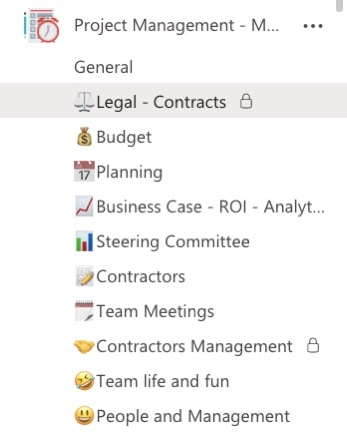
Each of your projects has accompanying documentation, especially if you are working directly with customers. Thus, create a delegated Private Channel for sharing customers’ information and contracts between the right participants. With newly created SharePoint Site Collection your documentation is under strong protection.
Internal communication between workers

During your work, you can communicate with many other partners, companies, freelancers, and subcontractors. Stay in touch with your internal team members and protect your information with Private Channels without creating a new team each time.
These are just a few examples, there are many more. With these examples, you can understand the main idea. Now let’s deep dive into these capabilities behind Private Channels, and how they work.
Discover 30+ Microsoft Teams use cases.
Private Channels in Microsoft Teams: How do they work?
Private Channels in Microsoft Teams give you the possibility to create a separated space only for defined members of your team. Use Private Channels according to your needs: limit the collaboration, share private documentation, and communicate on specific topics. You can perform different scenarios:
- Avoid creation of a new team for people working on separated topics
- Choose a group of people for communication around sensitive information right into the existing team
Private Channels Creation and Membership
Let’s talk about Private Channels creation and management specifics. First, each team member can create Private Channels by default. If you would like to limit Private Channels creation, you should manage it in the team settings as a Team Owner.
Another scenario – Private Channels creation management at the organizational level. Through Microsoft admin center you can choose users that can create Private Channels.
To create a Private Channel, just click in the “create more channels” button and choose the right privacy setting: standard or private. The Private Channel will contain the lock icon and only Private Channel Members will see this Channel.
Next, what is the difference between Private Channels Owners and Members?
The notion of Private Channels introduces two new roles. Now in a team, here are the distinct roles:
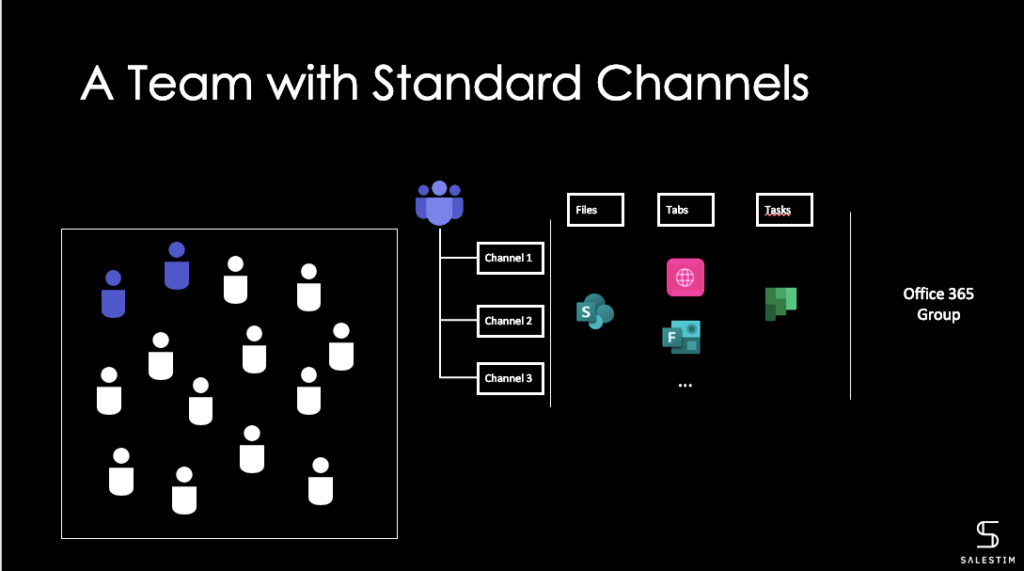
Team Owners
Team Owners can see all Private Channels and even delete them in their team. At the same time, they cannot see conversations, files, and Tabs if they are not Private Channels Members. We would like to pay your attention to the scenario when Private Channel Owner was removed from the team or Office 365. In this case, Team Owner automatically becomes the Owner of the Private Channels in the team.
Team Members
Any of the team members can be added to the Private Channel. At the same time, they cannot see even the Private Channel name if they aren’t Private Channel Members.
Guests
You can collaborate with someone outside of your team’s organization. The Private Channel Guest can see all the content, conversations, and documents. At the same time, they cannot manage settings, tabs, or apps.
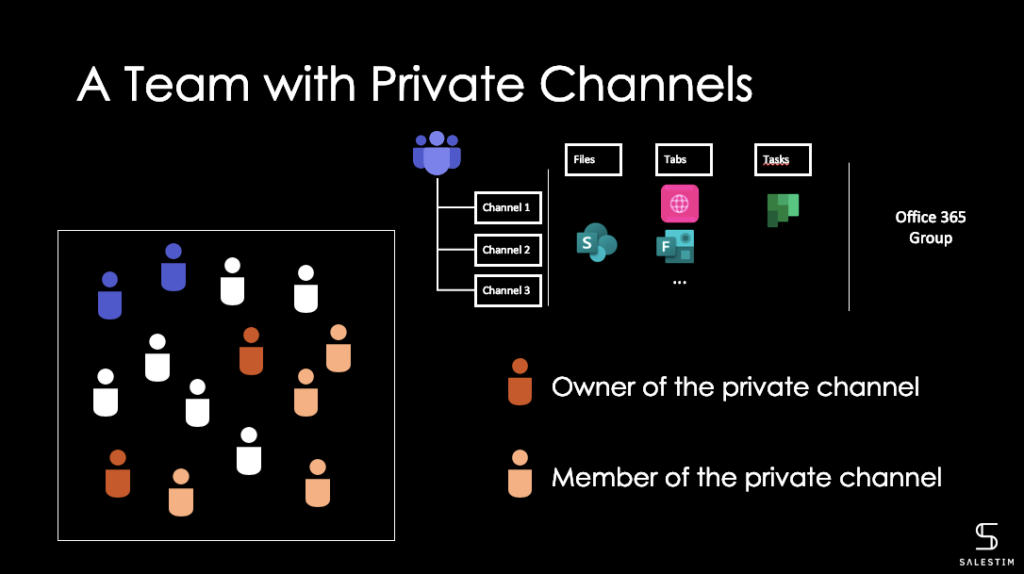
Private Channel Owner
The person who creates a Private Channel is the Owner of this Channel and only they can add or remove Private Channel Members. Each of the team members can be added to the Private Channels.
The Owner can also edit settings of the Private Channels. What’s important here is that in the newly created Private Channel the settings are the same as in the parent team. But only the Owner can easily change it.
The thing to know with Private Channel Owners is that they are not necessarily Teams Owners. A simple member can be a Private Channel Member. A Team Owner won’t be able to see the content unless the private channel owner invites this person.
Private Channel Member
The crucial point here is that a newly added Private Channel Member can see all old conversations and topics. Members can collaborate in a secure space, create new posts, tabs, and add files. Finally, they can leave private channels at any time. But they are not allowed to perform the same functions as the Owners do: to delete or restore deleted channel, add, or delete members and edit settings.
SharePoint with Private Channels
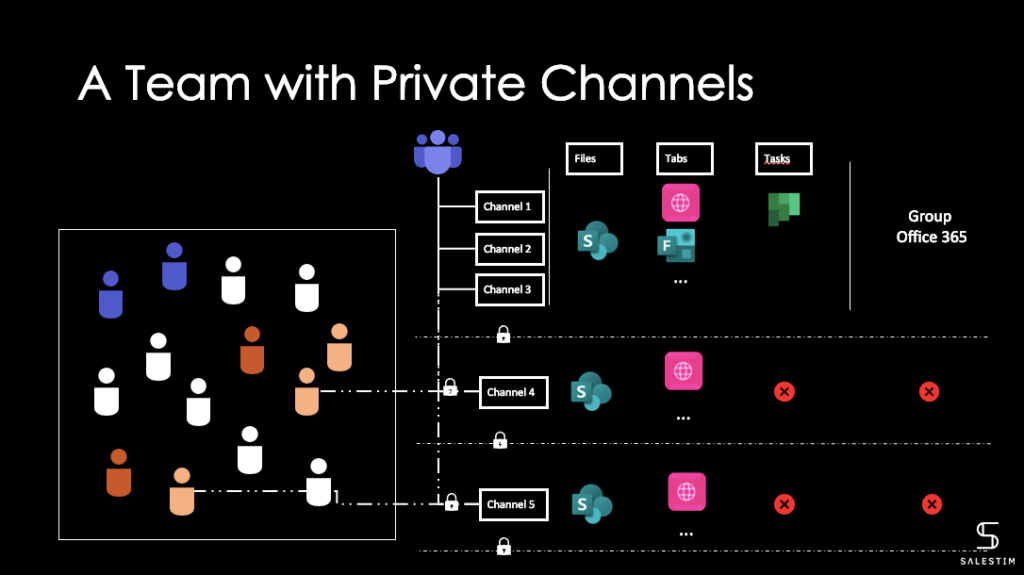
You may ask, what will be with the documents, created in the Private Channels?
For each Private Channel, the new SharePoint site collection is created in your Office 365. With a standard Channel, team owners have access to all the assets of the site collection. In the case with Private Channels, only its members have access to the files of the separated site collection.
Site Collections for the Private Channels are created with a document library. Also, the membership of this site is the same as the membership of the Teams Private Channel. However, the Owners can easily change the membership or even add Visitors to the Site Collection without needing to add them to the private Channels.
Microsoft Teams Private Channels: the things to know
One more time, we would like to pay your attention to some details to simplify your work with Microsoft Teams Private Channels. Here is the list of the different points that you should know when creating Private Channels:
1.Additional Silos: During the creation of Private Channels, you build completely new collaboration silos. Despite the fact that you create Private Channels inside your own teams, it works separately from some of your team members. It means that Private Channels have its own members, settings, and even SharePoint site collection.
2. Private Channels Membership Management: Team Owners are not the Private Channels Owners by default. Automatically, each team member can create a Private Channel and become its Owner if you won’t change the settings at the team or organizational level.
3. When the Private Channel Owner leaves the company, and no other Private Channel Owners are present, the owner is automatically becomes the Private Channels Owner. Therefore, the newly granted owner can manage the private channel and add other members that shouldn’t have access, which can lead to vital information security or compliance issues.
4. With Private Channel creation, the new SharePoint site collection is accompanying. These SharePoint Site are not seen in SharePoint Admin Sites. The only way to manage them is through PowerShell.
5. You can change the team settings and allow or forbid your team members to create Private Channels.
6. Private Channels have its own settings; thus you can perform many different cases according to your needs.
Private Channels Challenges
For sure, Private Channels is an excellent feature for Microsoft Teams Users. With careful usage it’s a powerful tool to protect your highly-secured information. However, there are some challenges that users face in their collaboration.
More Collaboration Silos
As we were talking before, with Private Channels your members are working with additional collaboration silos. It’s not a big deal if you have a few teams. But what if you are working in a large organization with many different projects, departments, and tons of documentation? In this case, additional structure, which has separate settings and environment, can become a real pain for you and your peers.
Increasing risks
Instead of the additional protection, you may get an increasing risk – for example, when the Private Channel owner leaves your Office 365 environment. This automatically gives the right to share information that is more sensitive.
Additional work for Team Owners
The team Owner should be careful with Team Settings. They must analyze the necessity of Private Channels creation in each case. Thus, they should not only manage membership in their teams but also carefully edit the settings and decide if they should allow or restrict the Private Channels Creation.
Additional charge on the IT Department
In the same way, there are additional pains for your IT Department. They should control all collaboration workflows with additional silos, membership, and settings to protect internal sustainability. With your Office 365 environment and various levels of access, you must have a strong organizational structure for a clear workspace.
Private Channels governance with Microsoft Teams templates
The advantage of having Microsoft Teams templates is that you can segment what is offered to employees in terms of both collaboration experience and governance. This all is our purpose at nBold. Combined with Private Channels, templates will help you a lot in getting the most of this capability while having the necessary governance policies.
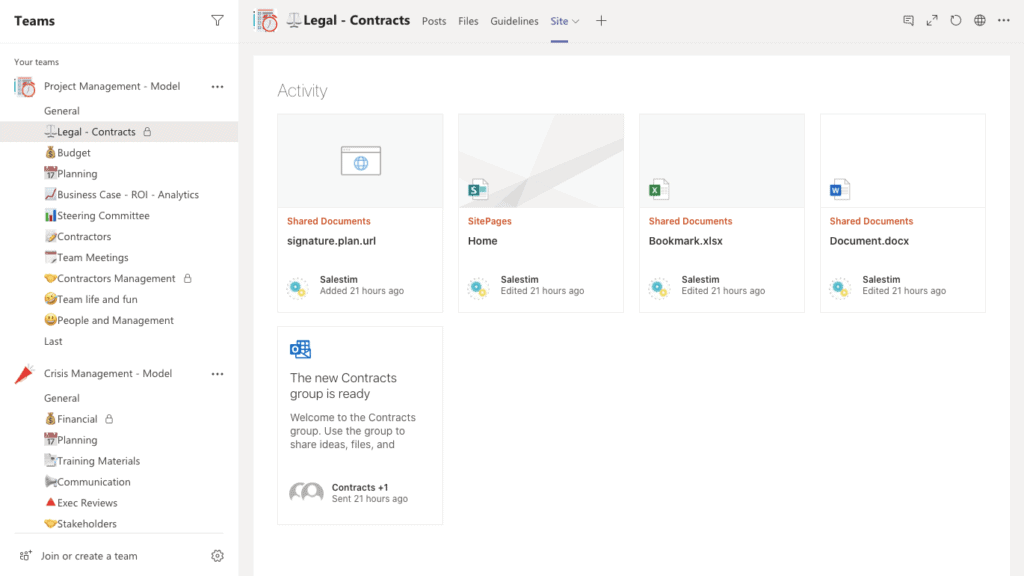
Get Private Channels for the right purpose
Just imagine, you don’t to spend any minute creating a team for every project you’re working on with a similar structure.
With nBold Technology you can easily build your own advanced Microsoft Teams Template catalog to support any Collaborative Processes depending on your business needs: for your new projects, sales teams, construction sites, new proposals, and much more. You can add relevant Public and Private Channels, manage settings, add members, and customize the Tabs. Rest assured, everything will be copied in a few seconds.
Build ready to go Private Channels according to the different scenarios. For example, add Documentation channel to your Project Management template with relevant tabs to share important files.
Include Default Owners for private channel
As mentioned earlier with the membership challenges, here is a real solution. When a team is created through a Template that includes Private Channels, it gets default owners.
During the new Template creation, you can easily manage the governance Policies and, for example, add Permanent owners for the teams created from the Microsoft Teams Template. Thus, each time someone creates a new team from the Template, Permanent owners will be added automatically. Moreover, they will be Private Channels Owners by default at the creation. As a result, only they will be allowed to manage membership in addition to the Team Requester.
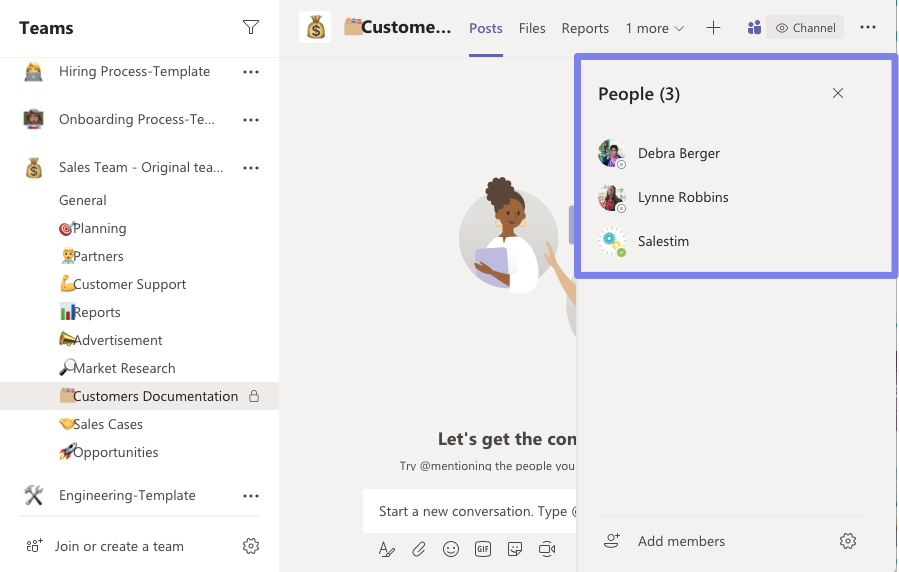
Members cannot create Private Channels by default
We saw that while Private Channels are offering great benefits, there’s a need to create too many collaboration silos, and therefore, too many Private Channels.
You can manage Private Channels creation settings at the Template Level. Just turn off the permission to create the Private Channels for needed types of the Templates. As a result, settings are copied, and members added to the newly created team from your template won’t be able to create Private Channels by default. This way you that members of the team won’t create additional Private Channels.
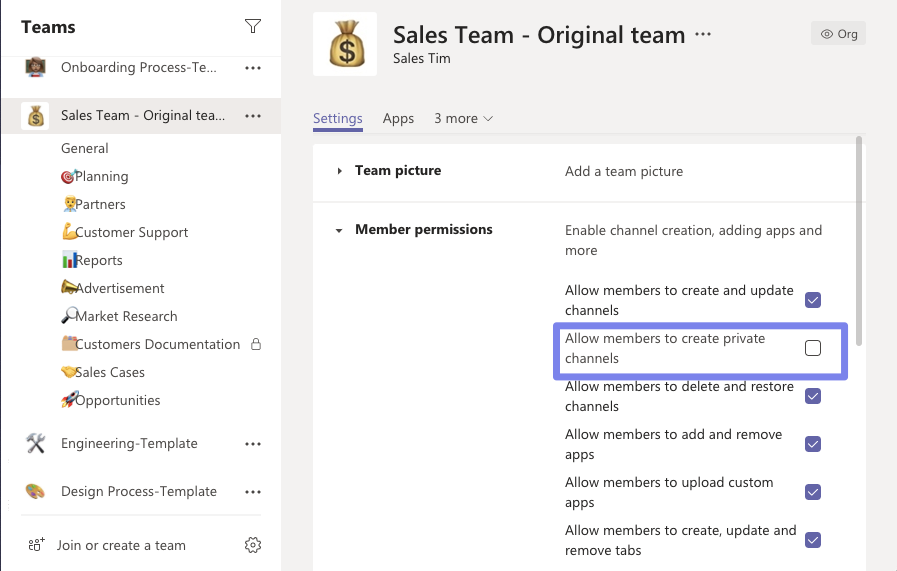
Serve Private Channels through Microsoft Teams Templates only
One more case is when Private Channels creation is not allowed at the organizational level.
But what should you do if you still need the space to collaborate on the secured information? With nBold in place, you can disable the permission to create private channels for any user in the tenant. So Private Channels will be served only through your Microsoft Teams Templates Corporate Catalog, and no user will be allowed to create private channels on any case.
You may wonder what is the magic behind? As nBold relies on a Secured Service Account, this is only one account which needs to be allowed to create private channels in the organization.
How does it work?
So how to create a Microsoft Teams Template with Private Channels, and how to set up Governance Policies?
1. Create an Original Team with Private Channels
Create an Original team with relevant Channels. Add Private Channels to communicate confidential information and share important documentation.

Manage teams’ Settings if needed. In this case we’ll make sure that the settings don’t allow its members to create private channels.
Add relevant Tabs to your Private Channels with your internal and external software. Everything will be copied automatically. Here is the example of the Website tab.
2. Add a new template
Using the nBold app, build a Template from the Original Team. Set up the Governance Policies with:
- Dynamic Naming Convention
- Approval Workflows
- Enforced Privacy
- Permanent Members and Owners… and more
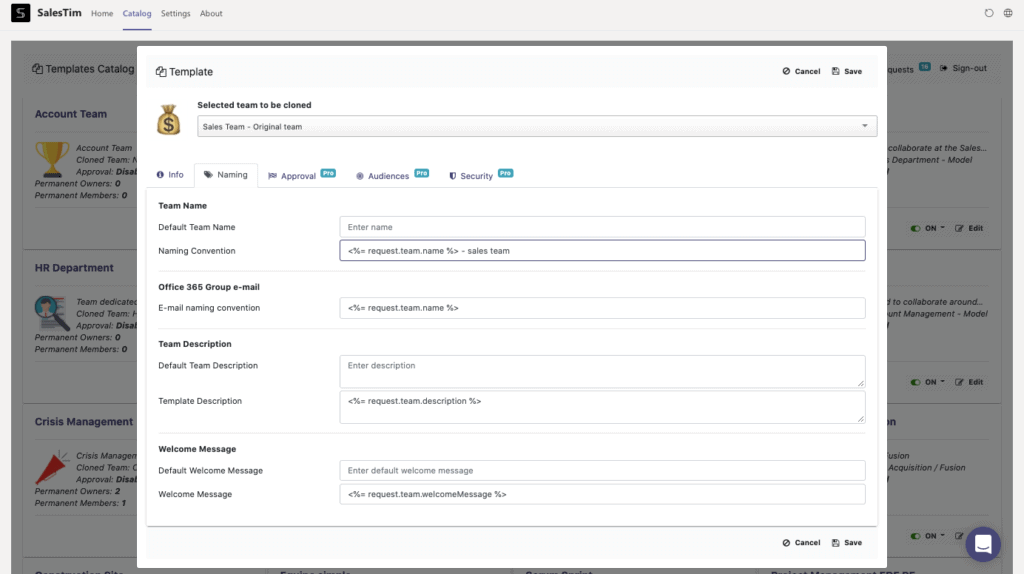
3. Create a Team based on the Microsoft Teams Template
Create teams from your existing template. Everything will be copied in a few seconds. Simplify your collaboration process with copied channels, tabs, and settings.
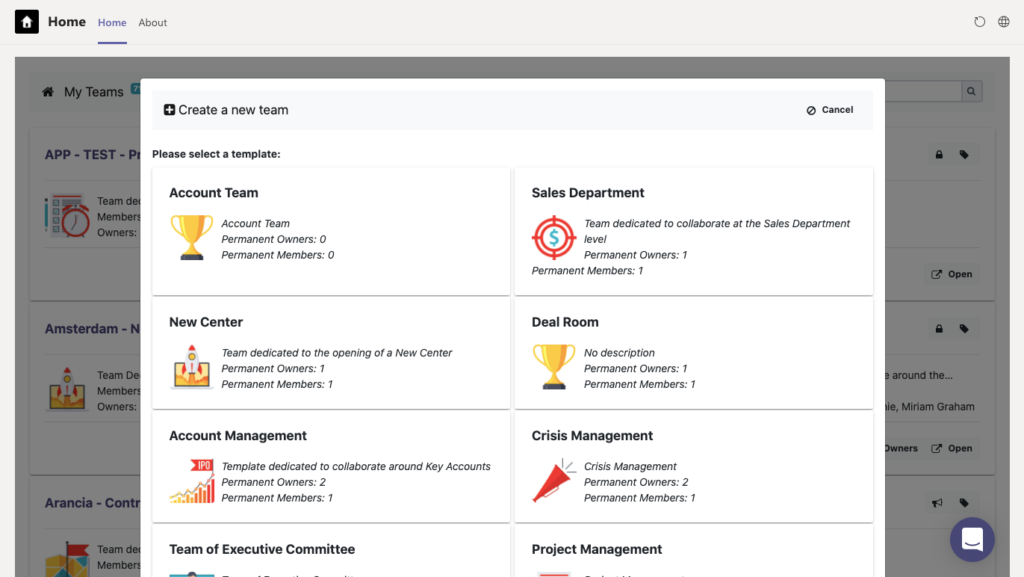
4. If needed, set the Microsoft Teams Policy to disable Private Channel creation for everyone
Limit the new collaboration silos with the restriction to create Private Channels at the organizational level. Thus, only members of teams created from your template will be able to collaborate through Private Channels.
Well done! Improve your collaboration processes and perform different cases according to your business and IT needs.
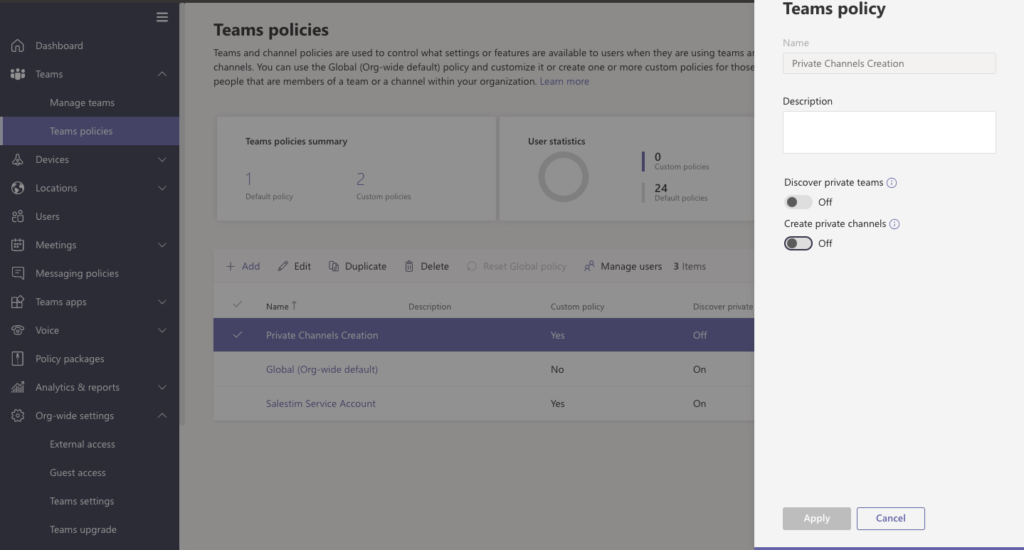
Microsoft Teams Private Channels is a great tool for your privacy security. You can easily protect your critical information and documentation with collaboration only between team members. At the same time, it lifts the additional charge from your managers and the IT department with the necessity of the additional control. Explore tons of useful software to simplify your work activity.
Head over to this blog post to learn Microsoft Teams security best practices.
Learn more about Private Channels on our Help Centre
